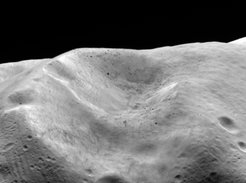The Surfaces of Asteroids
Motivation
Researching asteroids furthers our understanding of the evolution of our solar system. Asteroids are considered to be among the most pristine objects in the solar system and can therefore be used to find out how the early stages of planet formation and evolution looked like. It is hence important to constrain and determine the physical properties of these small bodies.
Method and Challenges

Most airless bodies in the solar system are covered with a particulate material, called regolith. It is created over time when meteorites impact onto the surface of another object cracking and fracturing the outer shell of the target body. Over millions of years the continuous impacts of these meteorites grind down the outermost part into the sand-like regolith.
The evolution of the regolith changes depending on e.g. the size of the object and its position within the solar system. But since the regolith forms the visible surface of these bodies and it is this material that is subject to remote sensing efforts, it is important to understand what it looks like and how it came to be as it is today.
One way to approach this problem is to look at the dynamical behavior of the regolith. It is subject to the (weak) gravitational attraction of the body it is covering and can therefore start flowing in a landslide under certain circumstances. It is known since the first space missions to asteroids that these landslides actually happen and by analyzing the flowing behavior of the regolith we can learn more about it.
Research Goals
Properties like grain size distribution, electrostatic charging or the magnitude of cohesion govern the flowing behavior of the regolith and will thus determine the way a landslide develops. By simulating landslides (e.g. the collapse of a steep crater slope) it is possible to narrow the space of values for these parameters and learn more about the temporal evolution of asteroid surfaces.
Another aspect of the surface dynamics on asteroids are possible trigger mechanisms for landslides. An experimental investigation into the flowing behavior of particulate material in reduced gravity is being conducted to find out whether small scale, slow impacts on meta-stable granular matter can act as a trigger event for landslides on asteroids.












